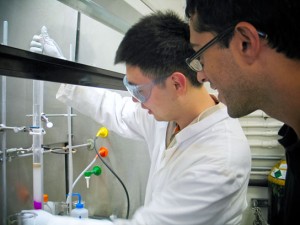Two chemists working on creating a synthetic cell
Thursday, January 26th, 2012 5:47:23 by Taimoor Tariq
Assistant professor of chemistry at the University of California, Neal Devaraj and a graduate student from Harvard University, Itay Budin, are currently working on creation of a ‘synthetic cell’. The duo’s goal is to create a living organism from non-living
molecules.
The duo has already created cell membranes that self-assemble from oil emulsion and detergent and are now hoping to replicate life’s origins. Using a novel chemical reaction, the two researchers and chemists were able to create self-assembling cell membranes
which support reaction required for life.
One of our long term, very ambitious goals is to try to make an artificial cell, a synthetic living unit from the bottom up – to make a living organism from non-living molecules that have never been through or touched a living organism,” Devaraj said. “Presumably
this occurred at some point in the past. Otherwise life wouldn’t exist.”
By doing this, they are hoping to illuminate life’s origins.
“We don’t understand this really fundamental step in our existence, which is how non-living matter went to living matter,” Devaraj said. “So this is a really ripe area to try to understand what knowledge we lack about how that transition might have occurred.
That could teach us a lot – even the basic chemical, biological principles that are necessary for life.”
Molecules that constitute the cell membranes have heads that mix with water while their tails repel it. They form a double layer in water and thus create a barrier that sequesters the contents of the cell.
Devaraj and Budin created similar molecules with a novel reaction that joins two chains of lipids. Nature uses complex enzymes that are themselves embedded in membranes to accomplish this, making it hard to understand how the very first membranes came to
be.
“In our system, we use a sort of primitive catalyst, a very simple metal ion,” Devaraj said. “The reaction itself is completely artificial. There’s no biological equivalent of this chemical reaction. This is how you could have a de novo formation of membranes.”
Other scientists have already announced the creation of a synthetic cell but the genome was artificial. A union of an information carrying genome and a three dimensional structure to house that genome is the major requirement of a fully artificial life form.
However, simplicity might be the reason behind the real value of this discovery. From commercially available precursors, the scientists needed just one preparatory step to create each starting lipid chain.
“It’s trivial and can be done in a day,” Devaraj said. “New people who join the lab can make membranes from day one.”
Tags: Harvard University, itay budin, lipids, molecule, neal deveraj, synthetic cell, University of CaliforniaShort URL: https://www.newspakistan.pk/?p=10627

















